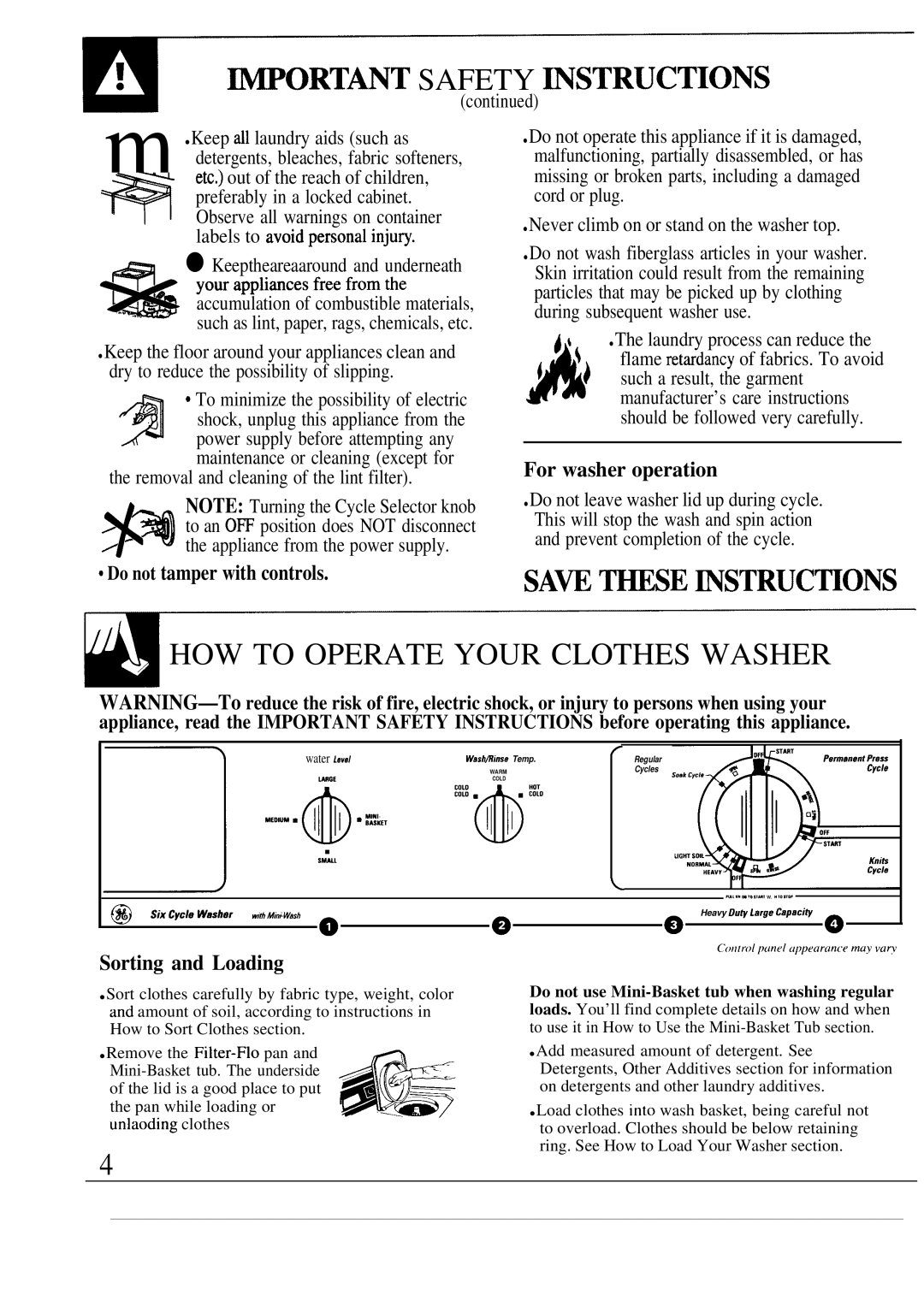
~ORTANT SAFETY ~STRUCTIONS
| (continued) |
|
| ||
| ● Keep dl laundry aids (such as | ● Do not operate this appliance if it is damaged, | |||
| detergents, bleaches, fabric softeners, | malfunctioning, partially disassembled, or has | |||
m etc.) out of the reach of children, | missing or broken parts, including a damaged | ||||
| preferably in a locked cabinet. | cord or plug. | |||
m Observe all warnings on container | ● Never climb on or stand on the washer top. | ||||
| labels to avoidpersonalinjury. | ||||
| ● Do not wash fiberglass articles in your washer. | ||||
| ● Keeptheareaaround and underneath | ||||
| Skin irritation could result from the remaining | ||||
| yourapphancesfreefromthe | ||||
| particles that may be picked up by clothing | ||||
. . . ., | accumulation of combustible materials, | ||||
during subsequent washer use. | |||||
* | such as lint, paper, rags, chemicals, etc. | ||||
|
|
| ● The laundry process can reduce the | ||
● Keep the floor around your appliances clean and |
| I’t | |||
| flame retardancy of fabrics. To avoid | ||||
dry to reduce the possibility of slipping. | i | i | |||
such a result, the garment | |||||
| c To minimize the possibility of electric | A | manufacturer’s care instructions | ||
| shock, unplug this appliance from the |
|
| should be followed very carefully. | |
9 | power supply before attempting any |
|
|
| |
|
|
| |||
| maintenance or cleaning (except for | For washer operation | |||
the removal and cleaning of the lint filter). | |||||
|
|
| |||
| NOTE: Turning the Cycle Selector knob | ● Do not leave washer lid up during cycle. | |||
. | to an OPP position does NOT disconnect | This will stop the wash and spin action | |||
/ | the appliance from the power supply. | and prevent completion of the cycle. | |||
* |
|
|
|
| |
c Do not tamper with controls.
SAW BSE MSTRUC~ONS
HOW TO OPERATE YOUR CLOTHES WASHER
water lev8/ | WasMinsn Temp. |
|
|
|
|
|
|
|
|
|
| ||||
|
|
| Regular |
|
|
|
|
| |||||||
|
|
|
|
|
| ||||||||||
| MGE |
| WARM |
|
|
| Cycles |
|
|
|
|
| |||
|
| COLD |
|
|
|
|
|
|
|
|
|
| |||
‘ED1uMm@m’’”ET | “’’@’”o |
| f |
|
|
|
|
| |||||||
| ■ |
|
|
|
|
|
|
|
|
|
|
|
|
| |
| SMU |
|
|
|
|
|
|
|
|
|
|
|
|
| |
|
|
|
|
|
|
|
|
|
|
|
|
|
|
|
|
|
|
|
|
|
| L |
|
|
|
|
|
|
| ||
|
|
|
|
|
|
|
|
| ,W,..m,,,!.”rW. HTO”OF |
|
|
| |||
|
|
|
|
|
|
|
|
|
|
|
|
|
|
| |
,ixCyC,.Wa.h.r m*WniWash ~ |
|
|
|
|
|
|
|
| Heavy Du~Large Capac;V | ||||||
3@ |
|
|
|
|
|
|
|
|
|
|
|
|
|
|
|
|
|
|
| e |
|
|
|
| Q |
|
|
| a |
| |
(.()))lr()[p(inel uppearan(e may vary
Sorting and Loading
●Sort clothes carefully by fabric type, weight, color and amount of soil, according to instructions in How to Sort Clothes section.
●Remove the
Do not use
●Add measured amount of detergent. See Detergents, Other Additives section for information on detergents and other laundry additives.
●Load clothes into wash basket, being careful not
to overload. Clothes should be below retaining ring. See How to Load Your Washer section.
4
